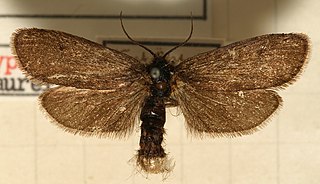
The pale November moth is a moth of the family Geometridae. The species was first described by Allen in 1906. It is a fairly common species in Western Europe including the British Isles.

The purple thorn is a moth of the family Geometridae. The species was first described by Johann Siegfried Hufnagel in 1767. It is a species of northern and central Europe. It has a scattered distribution in Britain but is absent from Ireland.

The swallow-tailed moth is a moth of the family Geometridae. The species was first described by Carl Linnaeus in his 1758 10th edition of Systema Naturae. It is a common species across Europe and the Near East.

Schreckensteinioidea is a superfamily in the insect order Lepidoptera containing a single family, Schreckensteiniidae, or "bristle-legged moths", because of the stout spines on the hindlegs. The superfamily and family were both described by Thomas Bainbrigge Fletcher in 1929. The relationships of this family within the group apoditrysia are currently uncertain. One of the species, the blackberry skeletoniser, is widespread and common across Europe and has been introduced as a biological control to Hawaii, whilst three species of Corsocasis occur in South East Asia.

Nepticulidae is a family of very small moths with a worldwide distribution. They are characterised by eyecaps over the eyes. These pigmy moths or midget moths, as they are commonly known, include the smallest of all living moths, with a wingspan that can be as little as 3 mm in the case of the European pigmy sorrel moth, but more usually 3.5–10 mm. The wings of adult moths are narrow and lanceolate, sometimes with metallic markings, and with the venation very simplified compared to most other moths.

Incurvariidae is a family of small primitive monotrysian moths in the order Lepidoptera. There are twelve genera recognised. Many species are leaf miners and much is known of their host plants, excluding Paraclemensia acerifoliella. The most familiar species in Europe are perhaps Incurvaria masculella and Phylloporia bistrigella. The narrow wings are held tightly along the body at rest and some species have very long antennae.

Epermeniidae or the fringe-tufted moths is a family of insects in the lepidopteran order with about 14 genera. Previously they have been divided in two subfamilies Epermeniinae and Ochromolopinae but this is no longer maintained since the last group is probably hierarchically nested within the first. They are presently placed in their own superfamily but have previously been placed among the Yponomeutoidea or Copromorphoidea with which they share some features. Their systematic placement among the apoditrysian group "Obtectomera" is however uncertain. They show some morphological similarities to the "plume moths", for example the wing fringe has similar groups of scales. There are also some similarities to Schreckensteinioidea, for example spiny legs and at least in some species an open-network cocoon. The genus Thambotricha from New Zealand may be the sister group of all other extant members. The most important genera are Epermenia, Ochromolopis and Gnathifera. The group has been extensively revised and catalogued by Dr Reinhard Gaedike.

Lypusidae is an obscure family of moths placed in the superfamily Gelechioidea.

Abraxas sylvata, the clouded magpie, is a moth of the family Geometridae that was named by Giovanni Antonio Scopoli in 1763.

Eupoecilia ambiguella, the vine moth, is a moth of the family Tortricidae. It is found in Europe, China, India, Japan, Korea, Mongolia and the Russian Far East.

Celypha rufana, common name lakes marble, is a small moth species of the family Tortricidae, long known under the junior synonym C. rosaceana.

Spoladea recurvalis, the beet webworm moth or Hawaiian beet webworm, is a species of moth of the family Crambidae. It is found worldwide, but mainly in the tropics.

Sitochroa palealis, the carrot seed moth, is a species of moth of the family Crambidae described by Michael Denis and Ignaz Schiffermüller in 1775. It is found in Europe and in 2002 the first specimen was reported in the United States.

Eupithecia dodoneata, the oak-tree pug, is a moth of the family Geometridae. The species can be found in Europe.

Agonopterix ocellana is a species of moth of the family Depressariidae. It is found in Europe and was first described by Johan Christian Fabricius in 1775

Ochropacha is a monotypic moth genus in the family Drepanidae. The genus was first described by Wallengren in 1871. Its single species, Ochropacha duplaris, the common lutestring, was first described by Carl Linnaeus in 1761. It is found in China (Jilin), Russia, Japan, the Korean Peninsula and from Central Asia to Europe.

Carcina quercana is a species of moth of the family Depressariidae. It is found in Europe. It has been introduced recently in North America, British Columbia and western Washington. It is occasionally known by several common names including oak lantern, long-horned flat-body, and oak-skeletonizer moth.

Agrotis bigramma, the great dart, is a moth of the family Noctuidae. The species was first described by Eugenius Johann Christoph Esper in 1790. It is found from along the southern shores of the Baltic Sea to China, the Levant and North Africa. Migrants have been reported as far west as Great Britain with three in one trap at St Agnes, Isles of Scilly on 10 August 1997.

Sabatinca incongruella is a moth of the family Micropterigidae. It is endemic to New Zealand.

Lithostege griseata, the grey carpet, is a moth of the family Geometridae. The species was first described by Michael Denis and Ignaz Schiffermüller in 1775. It is found in most of Europe, from Great Britain and the Iberian Peninsula to the Ural Mountains and further east to central Asia and Transcaucasia, Asia Minor and the Near East.




















